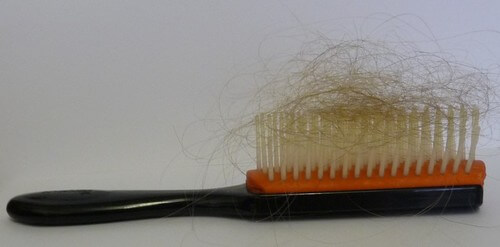Normal Hair Loss? Or Too Much Hair Falling Out?
By Paul Taylor

Everyone loses hair. But, whether you have excessive or normal hair loss all depends on a number of things.
This article explains four factors that determine whether or not the amount of hair falling out per day is completely normal or something more serious.
How Much Hair Loss Is "Normal" for You?
The answer to that all depends on how much hair you have in the first place. So whilst it's often been said that losing about 100 hairs per day is completely normal (1), that number can vary from person to person.
Here are the three main factors that influence how much hair you lose on a daily basis:
- #1 - The length of anagen. This is the growing phase of the hair growth cycle as explained on the previous page. Anagen will normally last 2 to 8 years (1).
- #2 - Scalp hair density.
- #3 - Any existing hair loss condition you might already have.
Here’s a simple example to explain how these factors can affect normal hair loss numbers:
In the photos below, you can see six people labeled A, B or C.

Let’s assume the following three things:
1. The man and woman labeled A both have a full head of hair and a high hair density (let's say they each have a total of 140,000 scalp hairs) but anagen lasts just a very short period of time (two years).
2. Those labeled B also have a full head of hair, but a lower hair density (let's say they each have a total of 100,000 scalp hairs) and anagen lasts a long time (six years).
3. Those labeled C have suffered severe hair loss, so let's say they each have a total of 70,000 scalp hairs and that anagen lasts an average period of time (four years).
Now, the people labeled A should expect to lose more hair each day than those labeled B.
That's for two reasons:
First, those labeled A have a lot more hair than those labeled B (40% more). And obviously, the more hair you have to start with, the more hair you’ll naturally lose per day.
The second reason is because, those labeled A have a much shorter growing phase (anagen ends 4 years earlier than it does for those labeled B). And this, quite simply means that more hairs will reach the shedding phase every day.
However, despite these differences, all these people labeled A or B can be considered to have normal hair loss.
As for those labeled C, obviously they definitely don’t have normal hair loss.
Quite clearly, with just 70,000 scalp hairs left, if they were to lose 100 hairs per day, this would represent a much higher proportion of their remaining hair than it does for, say, those labeled A (twice as much in fact).
However, to make matters even worse, many people with a hair loss condition unfortunately lose a lot more than 100 hairs every day!
Another Factor Affecting Normal Hair Loss Levels
#4 - Seasonal variation in hair loss
Our hair tends to grow faster during spring and summer. That’s because, in spring, when the amount of daylight starts to increase, this extra exposure to natural light appears to cause our hair growth cycle to speed up and cause more hair to enter the anagen (growing) phase (2).
But, this speeding up then causes many more hair follicles than normal to reach the end of anagen and enter telogen. And since telogen is the resting phase, this means that all those hairs have detached from their follicle roots and fallen out (or become club hairs ready to fall out through brushing or combing).
However, there can be a delay before you notice any increase in hair loss. That’s because it takes time to transition from the growing to resting phase.

But, despite this "lagging behind", things do slow down again during the winter months – both the rate of hair growth and amount of hair loss reduce back down to normal.
Exactly when your rate of hair loss starts to increase, how long it lasts for, and how much extra hair falls, are all things that can obviously vary from person to person.
Finally, it’s very important to remain aware of this seasonal variation in hair growth and hair loss because, any increased rate of shedding you experience should still be considered as simply part of your normal hair loss cycle.
In other words, don’t panic!
Hair loss synchronization
Like us, many other mammals also experience natural seasonal variations in their hair growth cycles, which then cause a fluctuation in their normal hair loss rate.
Cats and dogs, for example, have hair growth cycle synchronization, which causes a massive shedding event each year. And this, of course, is why many of our pets tend to annoyingly molt all over the place every spring.

Thankfully though, all of our hair follicles have a growth cycle
that’s completely independent from each other. So, no synchronization,
and no massive molting either. But, you can easily imagine the distress it
could cause if we did.
Whilst the subject of hair loss synchronization doesn’t normally apply to us, it does, however, lead on to a very interesting question concerning stem cell cloning.
If you are still worried that you might be losing more hair than you should, you might want to start checking your rate of hair loss on a regular basis:
How to Check Your Rate of Hair Loss
Here's an easy way to monitor whether you have normal hair loss or something more serious:
When you wash your hair, put a plughole protector in the sink or shower. This obviously collects all the hair and stops the plughole from clogging up.

But, before you bin the hair, grab it and put it into a bowl (or basin) of water. The hairs will float and separate, allowing you to count how many you just lost. Hopefully this number won't be too big!
If you then record this number, you can see day by day and week by week just how much hair you’re losing, and whether this rate stays steady or increases.
Keep in mind what you believe to be a normal hair loss level for you, and monitor it for a few months. This should hopefully give you a good idea about whether or not your rate of hair loss is anything to worry about.
Note: The same approach can also be used with your comb or brush - collect, count, record and compare. And, if you’re already using a hair loss product, this idea can also help you learn whether or not it's actually helping you.
Summary
There are several factors that can affect hair growth. And the amount of hair you lose on a daily basis can even vary throughout the year. So, what represents normal hair loss for one person, might well be regarded as high or low by someone else.
Those who never suffer any hair loss, probably won't even notice any fluctuation in their rate of hair loss at all. That’s because, even if there were an increase in shedding (say, due to seasonal variation) the amount they lose will still only be very small.
Essentially then, some people remain blissfully unaware of hair loss throughout their entire life.
I hope this article has helped reassure you if you’re concerned about the amount of hair falling out every day.
This is page 3 of 3.
Read previous page? Hair growth cycle.
|
Like this page? |
|

